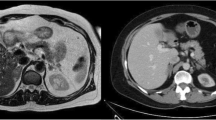Abstract
Background
Subclinical Cushing’s syndrome (SCS) is a well-described phenomenon where abnormalities of the hypothalamic–pituitary–adrenal axis exist in the absence of overt signs and symptoms of classic Cushing’s syndrome. While this has been shown to exist in 5–20% of patients with adrenal lesions, no standardized biochemical regimen exists to screen for SCS. Consequently, many of these patients may not be diagnosed prior to adrenalectomy with the risk of postoperative adrenal insufficiency. We began checking morning (a.m.) serum cortisol levels on postoperative day 1 (POD1) following unilateral adrenalectomy for nonfunctioning adrenal lesions to determine the incidence of unrecognized adrenal insufficiency (AI) in these patients.
Methods
One hundred and five patients undergoing adrenalectomy at a tertiary care center from 1999 to 2007 were retrospectively evaluated. Patients with Cushing’s syndrome, conditions associate with bilateral disease, and those receiving perioperative steroids were excluded, leaving 41 patients for analysis. A.m. serum cortisol levels were obtained in all patients POD1. Multiple factors were analyzed as possible predictors of AI. Analysis of variance (ANOVA), t-test, and chi-square test were used to determine statistical significance.
Results
The 41 patients’ diagnoses included 13 pheochromocytomas, 15 nonsecreting adenomas, 5 aldosteronomas, 5 metastatic lesions, 1 adrenocortical carcinoma, and 2 other benign lesions. Three groups were identified based on POD1, a.m. cortisol levels: sufficient (>10 μg/dl; n = 25, 61%), low-normal (3.4–10 μg/dl; n = 7, 17%), and insufficient (<3.4 μg/dl; n = 9, 22%). Tumor size and presence of diabetes, hypertension, and obesity were predictive of postoperative AI (p < 0.05).
Conclusions
AI after unilateral adrenalectomy without evidence of cortisol hypersecretion on preoperative screening was present in a significant number of patients in our series. Patients with diabetes, hypertension, obesity, and larger tumors may be at higher risk for postoperative AI. More thorough screening for cortisol hypersecretion may be warranted in patients with these characteristics, and obtaining routine postoperative cortisol levels may avoid potentially dangerous unrecognized adrenal insufficiency following adrenalectomy.
Similar content being viewed by others
References
Kuruba R, Gallagher SF (2008) Current management of adrenal tumors. Curr Opin Oncol 20:34–46
Petersenn S, Unger N, Walz MK, Mann K (2006) Diagnostic value of biochemical parameters in the differential diagnosis of an adrenal mass. Ann N Y Acad Sci 1073:348–357
Reincke M, Nieke J, Krestin GP et al (1992) Preclinical Cushing’s syndrome in adrenal “incidentalomas”: comparison with adrenal Cushing’s syndrome. J Clin Endocrinol Metab 75:826–832
Charbonnel B, Chatal JF, Ozanne P (1981) Does the corticoadrenal adenoma with “pre-Cushing’s syndrome” exist? J Nucl Med 22:1059–1061
Sippel RS, Chen H (2004) Subclinical Cushing’s syndrome in adrenal incidentalomas. Surg Clin North Am 84:875–885
Reincke M (2000) Subclinical Cushing’s syndrome. Endocrinol Metab Clin North Am 29:43–56
Mantero F, Terzolo M, Arnaldi G et al (2000) A survey on adrenal incidentaloma in Italy. Study Group on Adrenal Tumors of the Italian Society of Endocrinology. J Clin Endocrinol Metab 85:637–644
Grumbach MM, Biller BM, Braunstein GD et al (2003) Management of the clinically inapparent adrenal mass (“incidentaloma”). Ann Intern Med 138:424–429
Mantero F, Masini AM, Opocher G et al (1997) Adrenal incidentaloma: an overview of hormonal data from the National Italian Study Group. Horm Res 47:284–289
Young WF Jr (2007) Clinical practice. The incidentally discovered adrenal mass. N Engl J Med 356:601–610
Ross NS (1994) Epidemiology of Cushing’s syndrome and subclinical disease. Endocrinol Metab Clin North Am 23:539–546
Terzolo M, Osella G, Ali A et al (1998) Subclinical Cushing’s syndrome in adrenal incidentaloma. Clin Endocrinol (Oxf) 48:89–97
Rossi R, Tauchmanova L, Luciano A et al (2000) Subclinical Cushing’s syndrome in patients with adrenal incidentaloma: clinical and biochemical features. J Clin Endocrinol Metab 85:1440–1448
Leibowitz G, Tsur A, Chayen SD et al (1996) Pre-clinical Cushing’s syndrome: an unexpected frequent cause of poor glycaemic control in obese diabetic patients. Clin Endocrinol (Oxf) 44:717–722
Chiodini I, Torlontano M, Scillitani A et al (2005) Association of subclinical hypercortisolism with type 2 diabetes mellitus: a case-control study in hospitalized patients. Eur J Endocrinol 153:837–844
Mitchell IC, Auchus RJ, Juneja K et al (2007) “Subclinical Cushing’s syndrome” is not subclinical: improvement after adrenalectomy in 9 patients. Surgery 142:900–905 discussion 905 e901
Emral R, Uysal AR, Asik M et al (2003) Prevalence of subclinical Cushing’s syndrome in 70 patients with adrenal incidentaloma: clinical, biochemical and surgical outcomes. Endocr J 50:399–408
Huiras CM, Pehling GB, Caplan RH (1989) Adrenal insufficiency after operative removal of apparently nonfunctioning adrenal adenomas. JAMA 261:894–898
Terzolo M, Bovio S, Pia A et al (2007) Subclinical Cushing’s syndrome. Arq Bras Endocrinol Metabol 51:1272–1279
Shen WT, Lee J, Kebebew E et al (2006) Selective use of steroid replacement after adrenalectomy: lessons from 331 consecutive cases. Arch Surg 141:771–774 discussion 774–776
Messer CK, Kirschenbaum A, New MI et al (2007) Concomitant secretion of glucocorticoid, androgens, and mineralocorticoid by an adrenocortical carcinoma: case report and review of literature. Endocr Pract 13:408–412
Kageyama K, Sakihara S, Yamashita M et al (2008) A case of multiple endocrine neoplasia type II accompanied by thyroid medullary carcinoma and pheochromocytomas expressing corticotropin-releasing factor and urocortins. Am J Med Sci 335:398–402
Willenberg HS, Bornstein SR, Hiroi N et al (2000) Effects of a novel corticotropin-releasing-hormone receptor type I antagonist on human adrenal function. Mol Psychiatry 5:137–141
Fukuda T, Takahashi K, Suzuki T et al (2005) Urocortin 1, urocortin 3/stresscopin, and corticotropin-releasing factor receptors in human adrenal and its disorders. J Clin Endocrinol Metab 90:4671–4678
Arlt W (2008) Adrenal insufficiency. Clin Med 8:211–215
Hagg E, Asplund K, Lithner F (1987) Value of basal plasma cortisol assays in the assessment of pituitary-adrenal insufficiency. Clin Endocrinol (Oxf) 26:221–226
Jones SL, Trainer PJ, Perry L et al (1994) An audit of the insulin tolerance test in adult subjects in an acute investigation unit over one year. Clin Endocrinol (Oxf) 41:123–128
Author information
Authors and Affiliations
Corresponding author
Rights and permissions
About this article
Cite this article
Mitchell, J., Barbosa, G., Tsinberg, M. et al. Unrecognized adrenal insufficiency in patients undergoing laparoscopic adrenalectomy. Surg Endosc 23, 248–254 (2009). https://doi.org/10.1007/s00464-008-0189-1
Received:
Revised:
Accepted:
Published:
Issue Date:
DOI: https://doi.org/10.1007/s00464-008-0189-1




